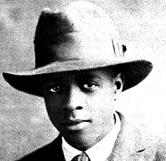Wallace Thurman facts for kids
Quick facts for kids
Wallace Thurman
|
|
|---|---|
 |
|
| Born | August 16, 1902 Salt Lake City, Utah, U.S. |
| Died | December 26, 1934 (aged 32) New York City, New York, U.S. |
| Occupation | |
Wallace Henry Thurman (born August 16, 1902 – died December 22, 1934) was an American novelist. He was an important figure during the Harlem Renaissance, a time when Black artists, writers, and musicians created amazing works. Wallace Thurman also wrote essays, worked as an editor, and published short-lived newspapers and magazines.
He is best known for his novel The Blacker the Berry: A Novel of Negro Life (1929). This book explored how people with lighter skin were sometimes valued more within the Black community.
Contents
Wallace Thurman's Early Life
Thurman was born in Salt Lake City. His father left his mother and him when Wallace was less than a month old. He didn't meet his father until he was 30 years old. Wallace and his mother often lived with his grandmother, Emma Jackson, in Salt Lake City. This was between his mother's many marriages.
Wallace's early life was sometimes difficult. He felt lonely, moved a lot, and often got sick. He started school in Boise, Idaho, at age six. But his poor health made him miss two years of school. During that time, he went back to live with his grandmother Emma. From 1910 to 1914, Thurman lived in Chicago. He moved with his mother and finished grammar school in Omaha, Nebraska. He also had ongoing heart problems during this time. In 1918, while in Pasadena, California, Thurman caught the flu during a big worldwide flu outbreak. He got better and returned to Salt Lake City, where he finished high school.
Thurman loved to read a lot. He enjoyed books by famous thinkers like Plato and Aristotle, and writers like Shakespeare and Flaubert. He even wrote his first novel when he was just 10 years old. He went to the University of Utah from 1919 to 1920, studying to become a doctor. In 1922, he moved to the University of Southern California in Los Angeles. However, he left without finishing his degree.
While in Los Angeles, he became friends with the writer Arna Bontemps. Thurman also worked as a reporter and writer for a newspaper owned by Black people. He started a magazine called Outlet. He hoped it would be like The Crisis, a magazine run by the NAACP, but for the West Coast.
Wallace Thurman's Career in Harlem
In 1925, Thurman moved to Harlem, a vibrant neighborhood in New York City. For the next ten years, he worked in many different jobs. He was a ghostwriter (writing for others), a publisher, and an editor. He also wrote novels, plays, and articles.
In 1926, he became the editor of The Messenger. This was a socialist magazine for Black people. Thurman left The Messenger in October 1926 to edit World Tomorrow, a magazine owned by white people. The next month, he helped start a new literary magazine called Fire!! Devoted to the Younger Negro Artists. Famous writers like Langston Hughes and Zora Neale Hurston wrote for it.
Thurman was only able to publish one issue of Fire!!. This magazine challenged older Black leaders like W. E. B. Du Bois. These leaders believed that Black art should help fight for social equality and racial integration. Thurman felt that the New Negro movement spent too much time trying to show white Americans that Black people were respectable.
Thurman and other young Black artists of the Harlem Renaissance wanted to show the real lives of African Americans. They wanted to show both the good and the bad parts. Thurman believed that Black artists should truly recognize and celebrate the difficult parts of African American life.
During this time, Thurman's apartment in Harlem became a popular meeting spot for Black artists and writers. He had painted the walls red and black, which were the colors he used on the cover of Fire!!
In 1928, Thurman was asked to edit another magazine called Harlem: A Forum of Negro Life. Writers like Alain Locke contributed to it. He only published two issues. After that, Thurman became a reader for a big New York publishing company. He was the first African American to have such a job.
Langston Hughes once described Thurman as "a strangely brilliant black boy, who had read everything." Hughes also said Thurman could find something wrong with everything he read. Thurman's dark skin color was often noticed. He even wrote about this in his books, criticizing how some in the Black community preferred lighter-skinned people.
Thurman wrote a play called Harlem. It opened on Broadway in 1929 and received mixed reviews. That same year, his first novel, The Blacker the Berry: A Novel of Negro Life (1929), was published. This novel is now seen as a very important book. It was one of the first to focus on how people within the Black community sometimes showed prejudice based on skin color.
Three years later, Thurman published Infants of the Spring (1932). This book made fun of the ideas and people of the Harlem Renaissance. He also wrote his last novel, The Interne (1932), with a white writer named Abraham L. Furman.
Personal Life and Passing
Thurman married Louise Thompson on August 22, 1928. Their marriage lasted only six months. They did not have any children.
Wallace Thurman died at the age of 32 from tuberculosis.
See also
- Harlem Renaissance
- African American literature

